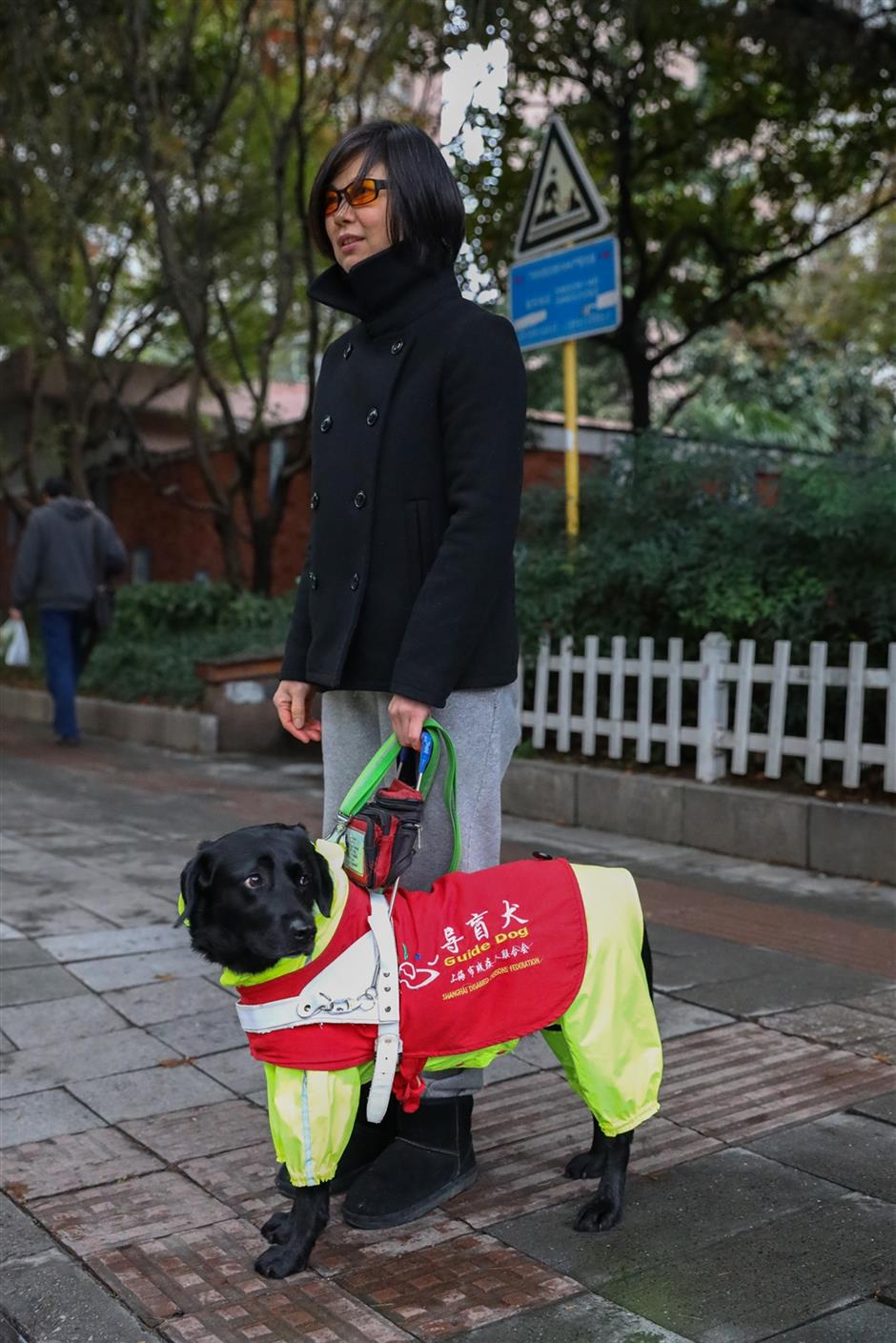Seeing-eye dog can see into owner's heart

Hu Lin, 36, and her guide dog Fang Ru
Shanghai resident Hu Lin, 36, and her dog never go anywhere without one another.
Blinded at the age of 13 by a medical procedure gone wrong, for the past 10 years, Hu has relied on Fang Ru, her Labrador retriever.
“She is like a daughter to me,” said Hu.
Fang Ru was the first guide dog in the city and understands commands in English, Mandarin and Shanghai dialect.
“When I first met her, I was very nervous,” said Hu. “I had no idea whether she would be able to help me.”
Fang Ru began her training at Nanjing Police Dog Research Institute when she was 4 months old. In 2008, Hu spent a month at the training center getting to know Fang Ru.
Trust between a blind person and a guide dog is essential. “For a totally blind person, it’s natural to have a sense of fear toward everything,” said Hu.
The first time Fang Ru led Hu outside, she deviated a bit to avoid a puddle. Hu was alarmed until the trainer explained what had happened. “At that point, I knew she was capable,” said Hu. “My concern about following her stopped. I gave myself to her without any fear.”
Fang Ru learns a new route after walking it just once. She never makes a mistake in the complex transport network of Shanghai, executing Metro transfers with ease.
Told the stop where Hu wants to disembark, the dog stands up when approaching the station. She knows how to take Hu to all her relatives’ homes.
She can tell from traffic flow when it’s safe to cross a street. At stairways, she slows down to indicate steps ahead.
“She stays to my left on staircases, positioning me with the handrail on my right,” said Hu. “She is more considerate than most humans.”
Fang Ru has been hit by vehicles several times. Her leg was broken when a tricycle swerved in front of them and the rider fled the scene.
“I didn’t know what had happened until a neighbor told me,” said Hu, wiping away a tear. Fang Ru was off work for a month.
“She has suffered many injuries because of me,” said Hu. “Our instinct is to flee from danger, but theirs is to protect us.”
When Fang Ru is in her “uniform,” she is all business. When the coat comes off, she becomes just another playful canine.
At home in Changning District, Fang Ru is called Pangzi, a Shanghai dialect term meaning “chubby,” though she is fit and far from fat. She is a seeing-eye dog who can see into Hu’s innermost thoughts.
Hu talks to Pangzi with an intimacy she doesn’t have with most people. “Guide dogs are not just a tool. They are an emotional support,” she said. “When I am unhappy or in tears, she lies down beside me.”
Once, when Hu was seized by a fit of vomiting, Pangzi grabbed a basin in her mouth and brought it to her.
“Every time I feel upset or ill, Fang Ru comes to my side,” Hu said. “She feels my emotions.”
She is also attached to Hu’s husband. When he fell ill and went to hospital, Fang Ru insisted on accompanying him and stood resolutely by during an exam that revealed an irregular heartbeat. While he was in the ICU, Pangzi anxiously paced around the house until he phoned and talked to her. Alone on a business trip to Beijing, Hu had to phone home every day to assure Fang Ru that nothing was amiss.

Du Lan, 46, and her guide dog Mu Lan
Guide dogs are still not allowed in many places, but the situation is improving.
“Ten years ago, only limited sections of the Metro were open to guide dogs.” Hu works as a masseuse near Jing’an Temple and needs to take a train to her job. “Even today, quite a number of places, including taxis and buses, won’t allow a guide dog.”
Hu said she won’t ever part from Fang Ru, even when she would normally be retired back to the training center.
“I will not do that even if it means I don’t get a new guide dog,” Hu said.
It has been 10 years since guide dogs were allowed in Shanghai, one of the first cities in China to introduce them, but there are still only 37 in the city, with four trainees at a base in Yangpu District. Training takes about six months. Demand is great, with between 20 and 30 applications for each dog.
Blind people are full of stories about how their lives have been changed by their dogs. Du Lan, 46, has had Labrador Mu Lan, 5, for three years.
“She brightens up my life,” Du said. “Although she cannot talk, I feel different in a positive way when she is with me.”
“She is quiet, well-behaved, docile, obedient and good-tempered. At first, I didn’t have much faith in her, fearing that I may bump into something, but she gradually won my trust.”
The dog lets Du know about mopeds or other vehicles on the sidewalk. If a passageway is too narrow, Mu Lan signals that they cannot walk side-by-side, and Du follows behind.
Mu Lan was hit by a moped once as they were crossing Chifeng Road. “She made a very frightening sound as she was hit,” Du said. “She had a cerebral concussion. I was very worried.”
But she recovered and the relationship grew even stronger.
“She comes to me when I am unhappy and licks me to comfort me,” said Du. “She is very considerate and she understands when I talk to her. She is very important to me, and I will keep her as long as she lives.”















